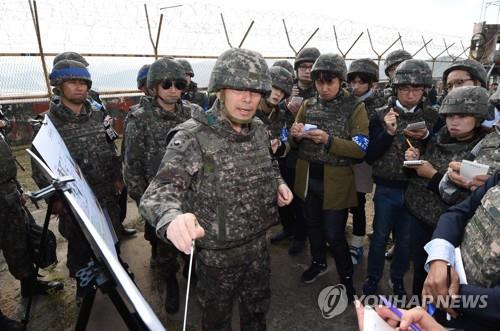- California Assembly OKs highest minimum wage in nation
- S. Korea unveils first graphic cigarette warnings
- US joins with South Korea, Japan in bid to deter North Korea
- LPGA golfer Chun In-gee finally back in action
- S. Korea won’t be top seed in final World Cup qualification round
- US men’s soccer misses 2nd straight Olympics
- US back on track in qualifying with 4-0 win over Guatemala
- High-intensity workout injuries spawn cottage industry
- CDC expands range of Zika mosquitoes into parts of Northeast
- Who knew? ‘The Walking Dead’ is helping families connect
DMZ demining operations lay groundwork for peninsula peace
CHEORWON, South Korea, Oct. 3 (Yonhap) — After a 15-minute bumpy ride along a dusty, hilly path inside the Demilitarized Zone (DMZ), dozens of South Korean troops in full gear disembarked near a grisly site of intense battles during the 1950-53 Korean War.
Accompanying them in the buffer zone separating the two Koreas was a phalanx of security guards, medical specialists and other personnel specializing in disposing of unidentified explosives and excavating war remains.
They are part of the 120-member team tasked with removing landmines in the Arrowhead Ridge, or Hill 281 in Cheorwon, some 90 kilometers northeast of Seoul — a site that the two Koreas have designated for a joint project to retrieve war remains from April to October next year.
There were three key battles against communist forces on the notorious ridge from 1952-53. The remains of more than 200 South Korean soldiers and dozens of U.N. Command (UNC) forces, such as U.S. and French troops, are thought to be buried in it.
“We have made preparations (for the landmine removal) for a long period and are well prepared now,” the commander in charge of the frontline areas told reporters on condition of anonymity on Tuesday, the second day of the demining work set to continue until Nov. 30.
“We will not rush and will carry out our mission with the first and foremost priority placed on the safety of our troops,” he added.

An Army official briefs reporters on demining operations inside the Demilitarized Zone on Oct. 2, 2018, in this photo provided by the Joint Press Corps. (Yonhap)
The demining task is key spadework for the excavation project, which is part of a comprehensive military agreement that the two Koreas’ defense ministers signed last month after the third summit between President Moon Jae-in and North Korean leader Kim Jong-un in Pyongyang.
The agreement fleshed out the military part of the first Moon-Kim summit declaration in April that pledged to transform the DMZ into a “peace zone” and called for joint efforts to halt “all hostile acts” against each other and practically eliminate the danger of war.
The major task of the border troops is to expand the width of two “safety paths” inside the Arrowhead Ridge, which were already made for security operations, to ensure that next year’s excavation project can safely proceed.
The two paths are 500 and 800 meter long, respectively, with their widths currently at around 2 to 3 meters. The troops plan to make the shorter path 10 meters wide and the longer one 4 meters wide.
The troops appeared aware that their mission is based on a greater cause than just clearing landmines in the no man’s land that juxtaposes carefree wildlife and symbols of fragile peace, such as rusty barbed wires and tense guard posts.
“The DMZ is a place where there are still risks of clashes, and it is a symbol of the two Koreas’ division,” Park Won-gon, a security expert at Handong Global University, said. “The demining work would be a natural procedure should the inter-Korean exchanges proceed in earnest with the prospect of possible reunification.”
The landmine removal scheme is only part of broader efforts to reduce military tensions, prevent accidental clashes and build trust between the two Koreas.
At last month’s summit, Seoul and Pyongyang reached a series of agreements, including disarming the Joint Security Area in the DMZ, removing some guard posts and setting up maritime, air and ground buffer zones to clear risks of clashes “in all spaces.”
At the mine removal site, the troops mobilized an array of high-tech tools, such as magnetic locators, mine detectors, compressors and grass eliminators, in a stark contrast to past demining operations that directly exposed troops to safety risks.
Once the troops find landmines or explosive devices, they put a marker on the spot so that staff from the Explosive Ordnance Disposal (EOD) team can handle them. The EOD team is to dispose of landmines in rear areas outside the DMZ.
Due to heavy gear, rough terrain and dust, the troops are allowed to conduct their work only for around 15 minutes at a time and then must take a break. Under an agreement with the North, they can do the demining work for two hours in the morning and another two in the afternoon.
Along with the mine removal, the troops are also involved in a project to create a 1.7-kilometer-long road inside the DMZ to give easier access to both South and North Korean personnel dedicated to recovering war remains next year.
All these activities in the DMZ will be carried out with cooperation from the UNC, a key enforcer of the armistice agreement that halted the Korean War. Some personnel from the UNC Military Armistice Commission (UNCMAC) were present on Tuesday to observe the entry into the DMZ of personnel and equipment for the demining work.
“Consistent with the spirit of the UN Armistice Agreement, as well as the recent comprehensive agreement between North and South Korea, the UNC authorized the current demining efforts ongoing at the Joint Security Area at Panmunjom,” UNC spokesperson Col. Chad G. Carroll said.
“U.S. Forces Korea will perform a support role to include having air medical evacuation assets available to respond within minutes of any potential medical emergencies,” he added.











